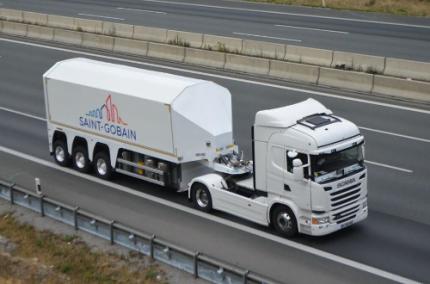Flat Glass driving towards carbon neutrality
Transportation accounts for one-quarter of the world’s greenhouse gas emissions, of that 74% is for road transportation. Using various solutions, Saint-Gobain Glass Logistics is intent on reducing the environmental footprint of glass transportation within the Group. Find out how.

Each year, Saint-Gobain Glass Logistics (SGGL) - Saint-Gobain Glass’s integrated freight forwarder - inloaders (trucks fitted with frames to transport flat glass) travel around 60 million kilometers in Europe, of which 40% are empty runs. It had become imperative to find solutions to improve glass transportation and to roll out cleaner modes of transportation to help meet the Group’s target of carbon neutrality by 2050.
Optimize logistics
SGGL’s prime goal was to reduce the number of inloader empty runs. Several measures have already been implemented with this in mind. The first was to reorganize truck fleet positioning at plants in an optimum way to improve operation coordination. A project is now underway in partnership with the supply chain teams to improve smoothing inter-plant glass orders, which will have a positive effect on the number of empty-run kilometers. Then to avoid empty return runs, trucks will load cullet for the return trip to production sites using big bags or containers. These measures alone have avoided 150,000 km of empty runs.
Digitalization is making rapid headway in all sectors, including road freight transportation. At SGGL, an efficient TMS (Transport Management System), the rollout of E-CMR (computerized transportation dockets), and the use of a track & trace tool and real-time CO2 emission monitoring are all having a positive effect on optimizing transportation to provide clients’ with even better service.
Develop new modes of transportation
While there is a lot of talk about multi-modal transport for people, it also exists for freight. It facilitates the transfer of trade worldwide while also reducing greenhouse gas emissions. Rail-road transportation cuts CO2 emissions by an average of 80% compared with road alone. Inloaders and tautliners loaded onto rail wagons should be able to reduce Saint-Gobain Glass Logistics road transportation by three million kilometers (projects in Germany for transport to Austria and Turkey are currently under examination).
The transloader is another solution. This hybrid trailer can transport glass on the outbound trip and conventional freight for the inbound trip. While it has some limitations (loading and unloading operations and limited to long distances), it is still an option being considered for certain non-optimized routes in partnership with SGGL’s historic carriers. And its impact on CO2 is 100%, as it avoids empty return runs.
Another source of cleaner transportation is Bio-LNG (biologically sourced liquefied natural gas) for trucks. It cuts CO2 emissions by an average of 15% compared with diesel, and reduces the emissions of fine particles by 95%. SGGL currently does not have any trucks of this type, but will have eight by the end of 2021.
In France, B100 (biofuel made from rape seed) can reduce emissions by 60% compared with diesel. However, as public gas stations do not stock this type of fuel, SGGL intends to install tanks at its plants or partner carriers’ premises, which should enable the rollout of this type of fuel across the entire French market by the end of the current year.
Minimizing transportation emissions also entails replacing the truck fleet with new a new generation of cleaner units by the end of 2021, which will cut CO2 emissions by 10%.
Finally, rail transportation using the Belt and Road Initiative (BRI) is of particular interest for transportation between Europe and Asia. SGGL has started using this type of transportation from Germany to China. Faster than sea freight (which is an average of 15 days), cheaper than air freight, easy to schedule and reliable, this type of transportation is also more ecological (10% reduction in CO2 emissions). It should be possible to introduce it soon from France, in particular because of the current tension around sea freight: skyrocketing prices - up 150% a year in the last quarter of 2020 - container shortages and considerably longer delays.
More economical and cleaner freight transportation, therefore, does not involve any one solution but a combination of several. Watch this space.




